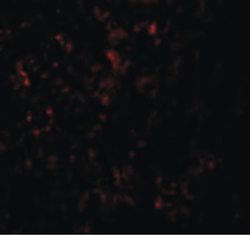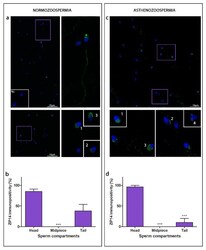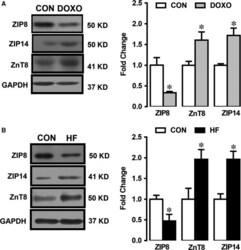Antibody data
- Antibody Data
- Antigen structure
- References [6]
- Comments [0]
- Validations
- Immunocytochemistry [1]
- Other assay [2]
Submit
Validation data
Reference
Comment
Report error
- Product number
- PA5-21077 - Provider product page

- Provider
- Invitrogen Antibodies
- Product name
- ZIP14 Polyclonal Antibody
- Antibody type
- Polyclonal
- Antigen
- Synthetic peptide
- Description
- Suggested positive controls are human liver, mouse kidney, or rat kidney tissue lysates. PA5-21077 can be used with blocking peptide PEP-1191. Predicted species reactivity based on immunogen sequence: Bovine: (94%). At least three isoforms of ZIP14 are known to exist; this antibody will detect all isoforms. ZIP14 antibody is predicted to not cross-react with other ZIP family members.
- Reactivity
- Human, Mouse, Rat
- Host
- Rabbit
- Isotype
- IgG
- Vial size
- 100 μg
- Concentration
- 1 mg/mL
- Storage
- Maintain refrigerated at 2-8°C for up to 3 months. For long term storage store at -20°C
Submitted references Heterogeneous Immunolocalisation of Zinc Transporters ZIP6, ZIP10 and ZIP14 in Human Normo- and Asthenozoospermic Spermatozoa.
Transferrin receptor 1 ablation in satellite cells impedes skeletal muscle regeneration through activation of ferroptosis.
Prolonged stimulation of insulin release from MIN6 cells causes zinc depletion and loss of β-cell markers.
Increased free Zn(2+) correlates induction of sarco(endo)plasmic reticulum stress via altered expression levels of Zn(2+) -transporters in heart failure.
Conditional mouse models support the role of SLC39A14 (ZIP14) in Hyperostosis Cranialis Interna and in bone homeostasis.
Iron importers Zip8 and Zip14 are expressed in retina and regulated by retinal iron levels.
Protic I, Golic I, Vidakovic S, Korac B, Korac A
Current issues in molecular biology 2022 Jul 31;44(8):3444-3454
Current issues in molecular biology 2022 Jul 31;44(8):3444-3454
Transferrin receptor 1 ablation in satellite cells impedes skeletal muscle regeneration through activation of ferroptosis.
Ding H, Chen S, Pan X, Dai X, Pan G, Li Z, Mai X, Tian Y, Zhang S, Liu B, Cao G, Yao Z, Yao X, Gao L, Yang L, Chen X, Sun J, Chen H, Han M, Yin Y, Xu G, Li H, Wu W, Chen Z, Lin J, Xiang L, Hu J, Lu Y, Zhu X, Xie L
Journal of cachexia, sarcopenia and muscle 2021 Jun;12(3):746-768
Journal of cachexia, sarcopenia and muscle 2021 Jun;12(3):746-768
Prolonged stimulation of insulin release from MIN6 cells causes zinc depletion and loss of β-cell markers.
Lawson R, Maret W, Hogstrand C
Journal of trace elements in medicine and biology : organ of the Society for Minerals and Trace Elements (GMS) 2018 Sep;49:51-59
Journal of trace elements in medicine and biology : organ of the Society for Minerals and Trace Elements (GMS) 2018 Sep;49:51-59
Increased free Zn(2+) correlates induction of sarco(endo)plasmic reticulum stress via altered expression levels of Zn(2+) -transporters in heart failure.
Olgar Y, Durak A, Tuncay E, Bitirim CV, Ozcinar E, Inan MB, Tokcaer-Keskin Z, Akcali KC, Akar AR, Turan B
Journal of cellular and molecular medicine 2018 Mar;22(3):1944-1956
Journal of cellular and molecular medicine 2018 Mar;22(3):1944-1956
Conditional mouse models support the role of SLC39A14 (ZIP14) in Hyperostosis Cranialis Interna and in bone homeostasis.
Hendrickx G, Borra VM, Steenackers E, Yorgan TA, Hermans C, Boudin E, Waterval JJ, Jansen IDC, Aydemir TB, Kamerling N, Behets GJ, Plumeyer C, D'Haese PC, Busse B, Everts V, Lammens M, Mortier G, Cousins RJ, Schinke T, Stokroos RJ, Manni JJ, Van Hul W
PLoS genetics 2018 Apr;14(4):e1007321
PLoS genetics 2018 Apr;14(4):e1007321
Iron importers Zip8 and Zip14 are expressed in retina and regulated by retinal iron levels.
Sterling J, Guttha S, Song Y, Song D, Hadziahmetovic M, Dunaief JL
Experimental eye research 2017 Feb;155:15-23
Experimental eye research 2017 Feb;155:15-23
No comments: Submit comment
Supportive validation
- Submitted by
- Invitrogen Antibodies (provider)
- Main image

- Experimental details
- Immunofluorescent analysis of mouse liver cells using a ZIP14 polyclonal antibody (Product # PA5-21077) at a 20 µg/mL dilution.
Supportive validation
- Submitted by
- Invitrogen Antibodies (provider)
- Main image

- Experimental details
- Immunofluorescence detection of ZIP14 transporter in normozoospermic ( a ) and asthenozoospermic ( c ) sperm samples using a confocal laser scanning microscope. Nc--negative control. Scale bar = 10 um. Average of total number of spermatozoa per ejaculate before processing was in normo- (625 x 10 6 /vol) and asthenozoospermia (367.5 x 10 6 /vol); For each type of sample, six randomly selected field areas were analysed (>100 cells). Relative immunopositivity of ZIP14 among the compartments in the normozoospermic ( b ) and asthenozoospermic ( d ) sperm samples. * in comparison to head, *** p
- Submitted by
- Invitrogen Antibodies (provider)
- Main image

- Experimental details
- Figure 2 Expression levels of ZIP 8, ZIP 14 and ZnT8 in heart tissue homogenates and doxorubicin-treated H9c2 cells. Representative Western blotting bands for protein expression levels are given left part of figures in ( A ) and ( B ). The densitometry analysis showing the proteins of ZIP 8, ZnT8 and ZIP 14 is expressed at 50 kD, 41 kD and 50 kD, respectively, in doxorubicin-treated H9c2 cells ( DOXO group) with respect to untreated cells ( CON group) ( A ) and underwent orthotopic heart transplantation with end-stage heart failure ( HF group) with respect to unsuitable for cardiac transplantation patients ( CON group) ( B ) GAPDH at 37 kD as reference protein. Bars represent mean (+-S.E.M.) for each group. Number of human samples, n = 3 for HF group and n = 2 for CON group. All measurements with double assays in each sample from each group for each type of measurement. Significance level accepted at * P < 0.05 versus CON.
 Explore
Explore Validate
Validate Learn
Learn Western blot
Western blot Immunocytochemistry
Immunocytochemistry